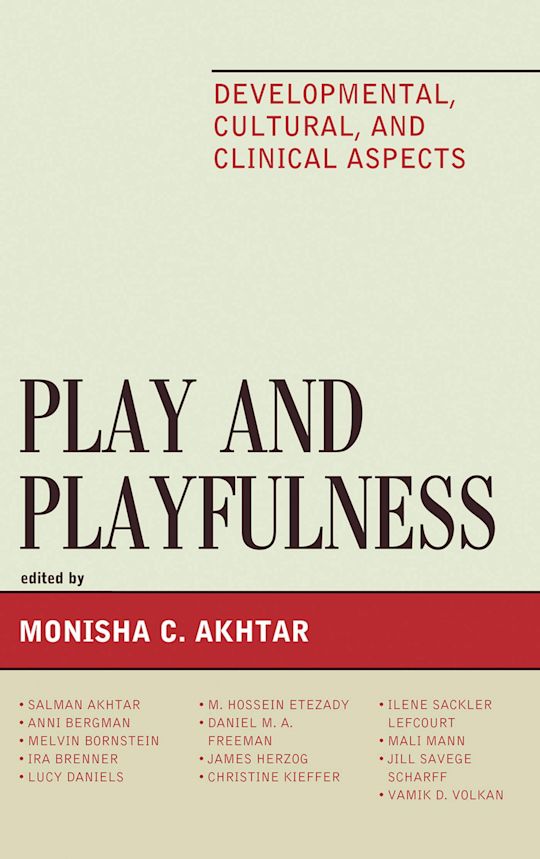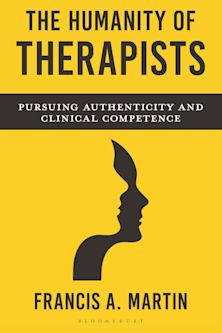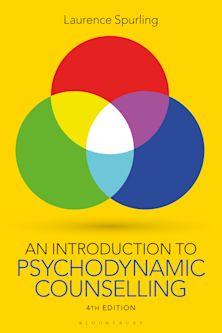- Home
- ACADEMIC
- Psychology
- Psychotherapy & Counselling
- Play and Playfulness
Play and Playfulness
Developmental, Cultural, and Clinical Aspects
Monisha Akhtar (Anthology Editor) , Salman Akhtar (Contributor) , Anni Bergman (Contributor) , Melvin Bornstein (Contributor) , Ira Brenner (Contributor) , Lucy Daniels (Contributor) , M. Hossein Etezady (Contributor) , Daniel M. A. Freeman (Contributor) , James Herzog (Contributor) , Christine Kieffer (Contributor) , Ilene Sackler Lefcourt (Contributor) , Mali Mann (Contributor) , Jill Scharff (Contributor) , Vamik D. Volkan (Contributor)
Play and Playfulness
Developmental, Cultural, and Clinical Aspects
Monisha Akhtar (Anthology Editor) , Salman Akhtar (Contributor) , Anni Bergman (Contributor) , Melvin Bornstein (Contributor) , Ira Brenner (Contributor) , Lucy Daniels (Contributor) , M. Hossein Etezady (Contributor) , Daniel M. A. Freeman (Contributor) , James Herzog (Contributor) , Christine Kieffer (Contributor) , Ilene Sackler Lefcourt (Contributor) , Mali Mann (Contributor) , Jill Scharff (Contributor) , Vamik D. Volkan (Contributor)
You must sign in to add this item to your wishlist. Please sign in or create an account
Description
While the psychodynamic understanding of play and play's therapeutic potential was long restricted to the realm of children, Winnicott's work demonstrated the profound significance of the capacity to play for healthy mental functioning during adult life. Scattered writings of Erikson, Glenn, and Shopper notwithstanding, the early spark of understanding remained largely ill developed. In Play and Playfulness, the reader is offered an exciting and highly informative set of essays about the psychic area that lies between reality and unreality and between veracity and imagination. It is the area of paradox and creativity. It sustains the self, allows for ego-replenishing regressions, and adds to the joy of the vital and lived experience. This book provides an easy and readable passage to the valley of the transitional experience in which creative synthesis of reality and unreality leads to a world of vigor, enthusiasm, and liveliness. The cultural variations and the clinical implications of such an experience are thoroughly elucidated. The result is a volume replete with technical virtuosity, clinical relevance, and the basic and nearly self evident humane music of the day-to-day experience of life.
Table of Contents
Chapter 2 Chapter 1-Self-Other Action Play: A Window into the Representational World of the Infant
Chapter 3 Chapter 2-Fathers and Play
Chapter 4 Chapter 3-Adolescence as a Time to Play
Part 5 Part II-Psychopathology
Chapter 6 Chapter 4-Neurotic Inhibitions of Play
Chapter 7 Chapter 5-Normal and Pathological Playfulness
Chapter 8 Chapter 6-Remembering, Replaying, and Working Through: The Transformation of Trauma in Children's Play
Part 9 Part III-Sociocultural Aspects
Chapter 10 Chapter 7-Cultural Pathways to Understanding Children's Play: Mythology and Folklore
Chapter 11 Chapter 8-Playing for Survival during the Holocaust
Chapter 12 Chapter 9-Play and Creativity
Chapter 13 Chapter 10-Play and Track II Diplomacy
Part 14 Part IV-Technical Implications
Chapter 15 Chapter 11-Aggression in Children: Origins, Manifestations, and Management through Play
Chapter 16 Chapter 12-Play and Very Young Children in Object Relations Family Therapy
Chapter 17 Chapter 13-Playfulness in the Adult Analytic Relationship
Chapter 18 References
Product details
| Published | 17 Jan 2011 |
|---|---|
| Format | Ebook (Epub & Mobi) |
| Edition | 1st |
| Extent | 252 |
| ISBN | 9780765707628 |
| Imprint | Jason Aronson, Inc. |
| Publisher | Bloomsbury Publishing |
About the contributors
Reviews
-
Freud defined good mental health as 'the ability to love, to work, and to play.' We have devoted much time to studying our ability to love and to work. Our 'ability to play' has gotten short-changed and needs our attention. This clinically relevant and highly enlightening book takes us from child's play to adult play, from the development-stimulating power of play to its use in problem-solving adaptation, even to its outwitting and out-battling trauma, and to its application to loosening the rigidities of adversarial diplomacy. This richly informing, superb book takes us on a journey from childhood to-as long as we live. We must know this for clinical work!
Henri Parens, MD, Thomas Jefferson University and Psychoanalytic Center of Philadelphia
-
Monisha Akhtar's book brings together an impressive array of experts to demonstrate that taking play seriously deepens our clinical knowledge, enriches technique, and reclaims the psychoanalytic understanding that play is central to all human endeavors.
Michigan Psychoanalytic Institute, Kerry Kelly Novick and Jack Novick, PhD, Michigan Psychoanalytic Institute



































